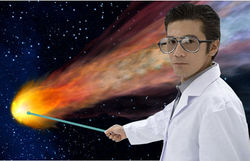Deep Impact
Deep Impact was a large space probe launched by respectable scientists as part of Operation Shit That's Awesome, an effort to change the world-wide perception of scientists as boring amoeba-counters, by blowing the fuck out of an apparently harmless rock. Its original target, an asteroid, was changed to Comet P9/Tempel 1 at the last moment, when it became apparent that blowing the fuck out of a massive fireball has a much higher Factor of Awesomeness () than blowing the fuck out of a boring, dead rock. However, to this day, the scientists involved in the project receive a great deal of well-deserved ribbing for having the lack of imagination to name the spacecraft after a mediocre motion picture.
Physics[edit | edit source]
After several previous missions failed embarrassingly due to errors in converting SAE units to metric, NASA decided to use units of the much simpler Common Man System for the Deep Impact mission, to avoid confusing the public and, presumably, its own engineers. For instance: the comet was described as approximately 0.5 "Manhattens" in diameter, while the spacecraft itself was exactly 1 "washing machine" across, the force of the impact (at 23,000 miles per hour) was around "1 washing machine crashing into 0.5 Manhattens", and the distance from Earth to Comet P9/Tempel 1 was expressed as "Tits! That's HUGE!" This approach was welcomed by the public, although it was believed that as much as 0.34% of the public could have understood regular numbers (either SAE or metric) just as well.
Timing[edit | edit source]
Unfortunately for the Awesome Science Dudes[1], their plans, much like several previous missions, had a tiny flaw: the spacecraft's timing was atrocious. Deep Impact was launched in January 2005, when most people were still chugging leftover New Year's champagne or getting ready for the Super Bowl, and went largely unnoticed. The mission completed successfully (see below) on the morning of July 4, 2005 GMT (when most people were asleep) and was most visible from a bunch of rocks in the middle of the Pacific, instead of anywhere people actually live. As such, it was viewed primarily by billions of migratory birds, insects, and empty air molecules. Once again, Bad Luck 1, Scientists 0.
Success Redefined[edit | edit source]
When you're a national space agency and things under your command have a nasty habit of vaporizing unexpectedly, what better way to achieve success than by blowing something up intentionally? Sure enough, the washing machine-sized bit got bashed to atoms by the half-Manhattan-sized bit. Several wavy lines were printed out by machines covered in blinking lights; blurry photographs were taken by the observing craft; a room-full of nerds made wet, off-center high-fives with their disgustingly clammy palms and the mission was declared a success.
Aftermath[edit | edit source]
Unfortunately, while the fact that "[the comet's center is] more dusty and less icy than had been expected"[2] makes male scientists erect and makes female scientists moist, the outcome of the mission proved to be far less interesting to the public than the outcome which had been promised to them by Hollywood—namely, a rain of comet chunks blasting apart New York and Washington, D.C., including the White House. As no one in the world remembers Deep Impact (the mission), while everyone in the world remembers Deep Impact (the mediocre film), it is quite clear that the original target—proving the innate bad-assery of your average astronomer—was missed by several kilometers.[3] For shame, NASA. For shame.


